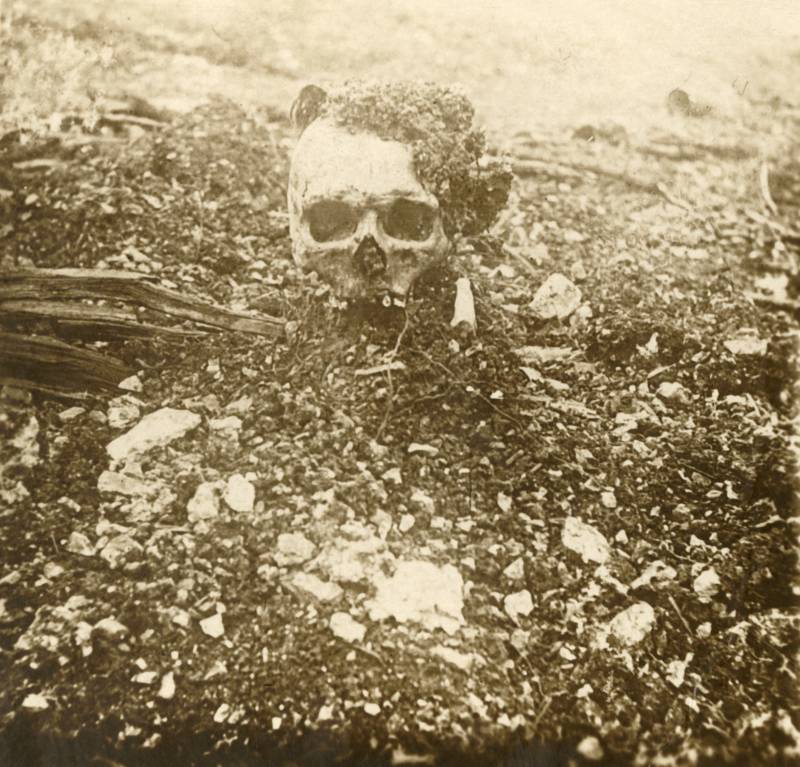

Small hollowed-out clay copies of the milestones, filled with the “sacred soil” of Verdun, counted among the most important souvenirs as long as the soldiers and their relatives were still alive. Still today, the milestones of this “Voie Sacrée” (Sacred Way) are decorated with oak leaves and steel helmets. This total commitment is symbolized by the “Noria” system, the constant coming and going of trucks and vehicles on the road from Bar-le-Duc to Verdun, which, starting in March 1916, at the rate of one vehicle every fourteen seconds, day and night, transported men and materials of all kinds – food as well as cannons – to the front. All soldiers thus actively participated in the defense of French soil. Behind this both laconic and proud phrase lies the awareness that here, outside of Verdun, almost all French soldiers fought at least once. What the French remember above all is the Order of the Day issued by General Pétain, the commander of the Verdun sector, on April 10, 1916: “Courage, on les aura!” (Courage! We shall get them!)Īs though in response to this authoritative assurance, today’s monument at Mort-Homme bears the inscription: “Ils n´ont pas passé“ (They did not pass). What also distinguishes Verdun is that the French military and political leadership already shortly after the start of the battle began to cast this sector of the front – which had previously been wantonly neglected (the cannons at Fort Douaumont had been dismantled in 1915, for they were urgently needed at other fronts) – as the scene of a decisive battle to bolster the morale of the nation and its soldiers. This incredibly grim close-quarters combat took place under the relentless fire from thousands of artillery of all calibers – the bombardment being so intense that, within a few weeks, the forested landscape around Verdun had been transformed into a veritable moonscape. Traversed by ravines and heights, the region around Verdun saw the armies perpetually charging towards each other, with the enemy almost always within sight. First and foremost, this has to do with the fact that, unlike at other battlefields such as at the Somme, the battles at Verdun were characterized by a rather special mix of close-range combat and long-range bombardment. But in French historical memory, Verdun occupies a unique place. They had done so before – at the Marne – and would do so again later – at the Somme –, where they incurred similarly high losses. There, the poilus had given their all, braving unspeakable suffering and mass deaths, to defend French soil against the Germans. In contrast, the French for a century have remembered Verdun as an absolutely meaningful battle. In hindsight, it was above all the soldiers, which had bled as much as their French counterparts at Verdun, who came to see their enormous sacrifice as lacking sense or meaning. But this “bleeding to death” plan has, of course, darkened the German memory of Verdun. Historical research of the last decades has shown that this plan – the so-called “Christmas Memorandum” of 1915 – was a post-war fabrication to gloss over the Germans’ effective defeat at Verdun. Moreover, both nations still remember the plan of the German Chief of Staff Erich von Falkenhayn, who claimed that he had never intended to conquer Verdun but to “bleed to death” the French army. Although these figures were surpassed later, Verdun for the first time brought losses of this magnitude and thus engraved itself deeply into collective memory. On the German side, 143,000 soldiers were killed, while the French counted 167,000 dead. The reality was far from it, but the figures are nevertheless dramatic: taken together, both armies suffered some 700,000 “casualties” – that is, dead, wounded, and missing persons (336,000 Germans 362,000 French).

It is said that 1 million soldiers were killed. It is more widely and vividly remembered than even the battles that consumed more “human material” and materiel, such as the Battle of the Somme in the summer of 1916.įirst of all, both in France and in Germany, Verdun is remembered for its enormous “casualty” figures, even though fantasy numbers are frequently bandied about. In both France and Germany, the Battle of Verdun (February 21 – December 20, 1916) still today is seen as the most significant battle of the First World War.


 0 kommentar(er)
0 kommentar(er)
